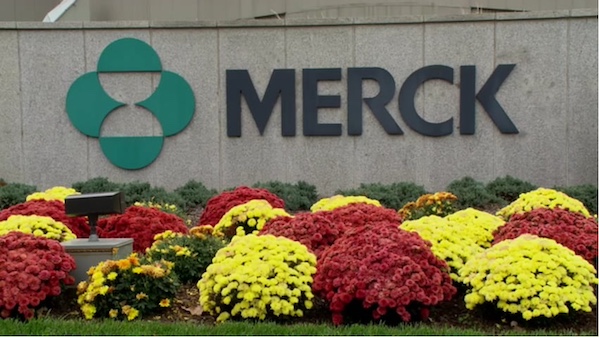Merck expects $20B+ in new cancer sales thanks to Daiichi ADC deal, Moderna vaccine
January 11, 2024
Source: drugdu
 247
247

While some Merck & Co. investors may still get the heebie-jeebies when thinking about Keytruda’s patent cliff in 2028, but the company’s CEO Rob Davis now thinks “it’s just another year.”
Make no mistake, given Keytruda’s size, an overall business decline will likely still hit. But Merck is focused on making “the hill to dip as small as possible and the return to growth as fast as possible,” Davis said Monday at the 2024 annual J.P. Morgan Healthcare Conference.
Davis and Merck Research Laboratories President Dean Li, M.D., Ph.D., pointed to the breadth of Merck’s portfolio across oncology, infectious disease, cardiometabolic, immunology and neuroscience to explain Merck’s potential for growth.
“I know that the conversation continues to be about Keytruda and 2028,” Davis said. “But increasingly, we’re not focused on 2028. 2028, it’s just another year, it’s just another point. We’re focused on 2030 to 2040.”
At last year’s J.P. Morgan conference, Merck laid out a projection to potentially have more than $10 billion in sales from oncology drug candidates in its pipeline. On Monday, Davis increased that number to more than $20 billion by mid-2030s.
The improved outlook now includes three antibody-drug conjugates that Merck just in-licensed from Daiichi Sankyo for $4 billion upfront. Among them, HER3-targeted patritumab deruxtecan in December received FDA priority review for its application as a third-line therapy for EGFR-mutated non-small cell lung cancer (NSCLC).
The $20 billion-plus number also counts Moderna-partnered cancer vaccine V940, which has shown promising phase 2 data alongside Keytruda as a postsurgical adjuvant treatment for melanoma. The two companies have in July advanced the combination into phase 3 testing in resected stage 2b to 4 melanoma, and they in December initiated another phase 3 for the regimen as an adjuvant therapy in stage 2 to 3b NSCLC.
“One of the concerns that someone might have in relationship to an [individualized neoantigen therapy] that’s based on mRNA is the durability,” Li said. “What you see with the press releases that come up […] that durability is real. When you treat in earlier stage, and you have that [durable effect], that’s when a patient starts thinking the word potential cure.”
Keytruda itself is currently undergoing a key launch in early-stage NSCLC. The FDA doled out the first-in-class approval for continuous use of Keytruda both before surgery in the neoadjuvant setting and after surgery as an adjuvant therapy in October based on an overall survival win from the Keynote-671 trial.
Merck has previously cautioned a slow sales ramp for an earlier nod that allows Keytruda solely as an adjuvant therapy. But Davis and Li during Monday’s presentation adopted a much more bullish tone for the neoadjuvant-plus-adjuvant indication.
Li called the Keynote-671 overall survival readout a “watershed moment.” The Keytruda regimen is now the only checkpoint inhibitor that boasts the highest Category 1 recommendation on the National Comprehensive Cancer Network guidelines for early-stage lung cancer, Li noted. With proper screening, 8 out of 10 Keytruda patients in metastatic NSCLC could be eligible for the PD-1 inhibitor in an earlier stage, he said.
Merck and other PD-1 developers have made heavy investments in early-stage cancers. Eight indications in early-stage tumors drove about 20% of Merck’s total global revenue in 2023, and Davis said the company expects to reach 25% in 2024. And the company has more than 20 registrational studies in other adjuvant areas.
Davis suggested that because Keytruda is used more often as a single agent in early-stage disease, that gives a potential subcutaneous version of Keytruda a better chance to soften the blow when the original infused formulation loses market exclusivity in 2028. For the perioperative NSCLC indication, Keytruda is given alongside chemotherapy before surgery for up to four cycles and then as a monotherapy after surgery for up to 13 cycles.
Besides oncology, Davis also dialed up Merck’s mid-2030s sales outlook for its cardiometabolic candidates from more than $10 billion to around $15 billion. The updated projection now includes MK-6024, a GLP-1/glucagon receptor dual agonist that entered phase 2b for the treatment of nonalcoholic steatohepatitis, or MASH. It also incorporates increased confidence in sotatercept, which is under FDA priority review in pulmonary arterial hypertension, and MK-0616, an oral PCSK9 inhibitor for which Merck in 2023 launched multiple phase 3 trials.
https://www.fiercepharma.com/pharma/jpm24-merck-expects-over-20b-post-keytruda-sales-new-cancer-drugs-thanks-daiichi-adc-deal
By editorRead more on
- Jinghong Medical Secures Series A Strategic Financing, Co-led by Venture Capital and Binhu Industrial Group with FTEC Capital as Exclusive Financial Advisor December 29, 2025
- Brazil to launch single-dose dengue vaccination program; Chinese companies help boost vaccine production capacity December 29, 2025
- China Biopharmaceutical’s innovative drug TQH3906 completes Phase II clinical trial. December 29, 2025
- Transcenta Group-B and EirGenix Reach Biopharmaceutical Manufacturing Collaboration Agreement December 29, 2025
- Sinovac Biotech’s adsorbent tetanus vaccine officially launched December 29, 2025
your submission has already been received.
OK
Subscribe
Please enter a valid Email address!
Submit
The most relevant industry news & insight will be sent to you every two weeks.



